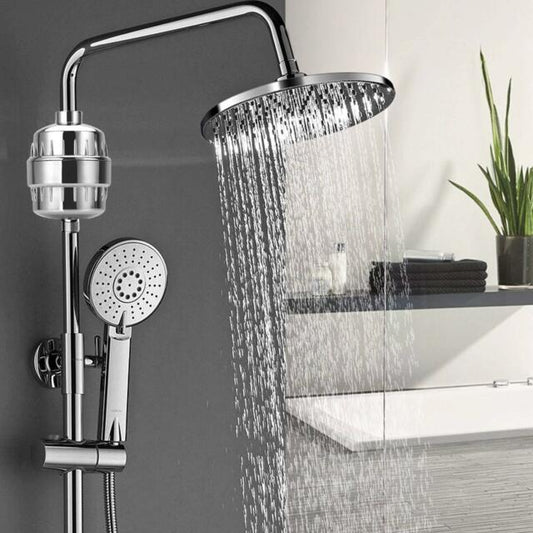A whole house water filtration system can remove all kinds of contaminants from your house’s water supply. Of course your requirements will depend on your home’s water supply. You may be bothered by the smell of chlorine in your water or you may want to reduce your water’s hardness levels. Whether you want to fix hardness or remove sediments, you can choose from a wide variety of whole house filters.
Plumbers install whole house filters where a home’s main waterline begins. This is why they are also referred to as point-of-entry tap, as it gives you access to filtered water across the house.
Carbon Filters
Carbon is widely used in water filtration processes. All types of water filtration systems, such as pitcher filters, shower filters, refrigerator filters, and reverse osmosis water filtration systems, utilize carbon.
The carbon in carbon water filters comes from grinding up sources such as coconut shells, bituminous coals, or peat. While the carbon source could be any one of these, the most commonly used ones are coconut shells. This may be because they are a highly renewable source of carbon.
Like any kind of water filter, carbon filter is used to capture substances that may be contaminating water. The detoxifying quality of carbon was first discovered by ancient Egyptians. However, carbon still remains a priority when it comes to removing water contaminants.
While carbon does a lot of detoxifying, its primary use in a water filter is the removal of chlorine. Municipal water suppliers use chlorine to kill bacteria in water pipes as well as the water itself. Although it is quite safe to consume, chlorine also tends to leave behind a certain odor and smell. Fortunately, carbon water filters can remove this. Not only do they improve the taste and smell of your water, they also ensure that water is safer to consume. Carbon significantly reduces the presence of chemicals like herbicides and pesticides.
How Do Carbon Filters Work?
Carbon water filters contain activated carbon granules that are quite similar to charcoal. These granules have numerous pores along their surface as well as structure. Besides this, their surface area is also quite enormous, meaning it is packed with lots of small spaces.
As water runs through the activated carbon granules, a process called adsorption takes place. The pores in the granules trap impurities and chemicals and purified water emerges on the other side. This process is similar to how a magnet attracts iron fillings. The contaminants that are captured at this stage include solvents, pesticides, and heavy metals.
The filtration system also includes activated catalytic carbon. It is specifically present for the removal of chlorine and chloramines from your water. Chloramines are similar to chlorine, having the same disinfectant properties. Some municipal suppliers make use of chloramines as an alternative to chlorine. Their removal from water is relatively difficult, which makes the presence of catalytic carbon important. Catalytic carbon breaks apart the molecules much better than the regular form of activated carbon.
Types of carbon filters
There are a few different types of carbon filters that serve diverse purposes.
1. Granular Activated Carbon Filters (GAC)
These filters contain loose activated carbon granules, which allow easy flow of water. They make use of a carbon cartridge, which contaminated water flows through. The water and carbon make contact when water passes through the cartridge, and adsorption takes place.
Advantages: Flow of water is easy and takes place at a faster rate.
Disadvantages: Channeling of carbon can take place, allowing contaminants to pass through.
2. Carbon Block Filters
In carbon block filters, the granules are held together with a bonding agent. This only takes up about 15% of the surface area. When the carbon granules are ground into even finer pieces, it increases the surface area. Water flows inside the filtration system from one side and filtered water exits it from the top.
Advantages: The surface area of a block filter is about 7 to 10 times greater than that of a GAC. The risk of carbon channeling is also low due to the compactness of the carbon.
Disadvantages: The flow is not as fast as the GAC filter. It is rather quite restrictive.
3. GAC Carbon Filters with a Radial Flow
These filters are a combination of the features a carbon block filter and a granular activated carbon filter offer. They have a surface area similar to the carbon block filter, but a rate flow of the GAC filter. Water flows through the side of a carbon block. The difference is that the block contains granules to allow an increased flow rate.
How Safe Are These Filters?
You do not need to worry about safety while using a carbon filter. All carbon filters are rated for CTO removal but it is even better if yours is rated by a third party. They remove all kinds of contaminants that may be present in water, including lead and cysts. Not to mention, carbon filters also carry out mechanical filtration.
Conclusion
Whole house filters do an amazing job of allowing you access to clean and purified water from every outlet of your home. Carbon whole house filters are primarily used to eliminate the odor and smell issues of chlorine and chloramines. However, they also work best for other contaminants.






